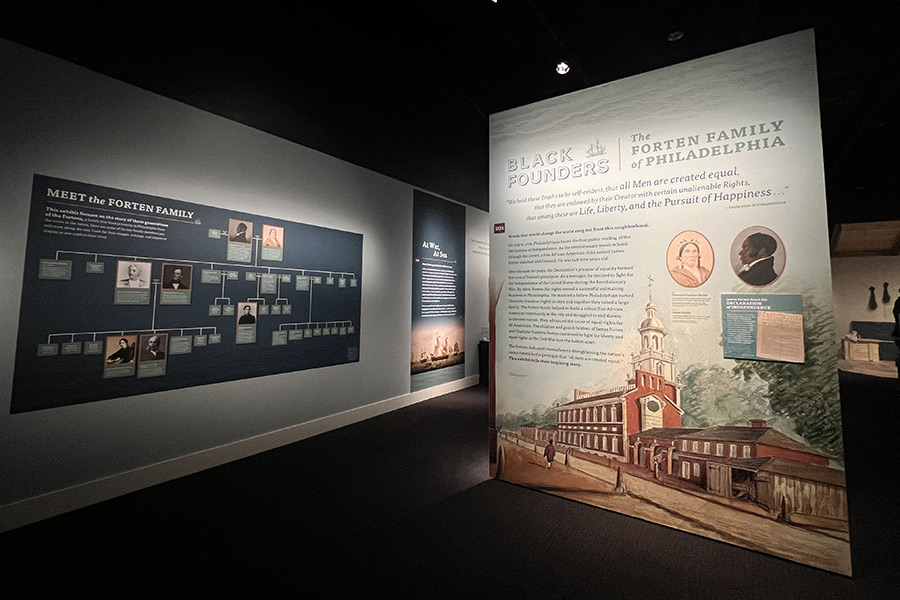New James Forten Exhibit Brings the Black Founding Father to Life
“It’s a great American story, and a great reminder that American history is not simple.”

“Black Founders” explores the legacy of James Forten and his family / Photograph by Laura Swartz
James Forten was nine years old when the Declaration of Independence was read aloud just blocks from his house. He was born free in 1766, yet “All men are created equal” still did not apply to people who looked like him — and this Black Founding Father’s story is not widely remembered.
With their new exhibit, Black Founders: The Forten Family of Philadelphia, the Museum of the American Revolution hopes to change that.
The exhibit features more than 100 historical artifacts to tell the stories of the Philadelphia abolitionist and businessman, as well as his family and descendants through the present time. In addition to the artifacts on display, Forten will be brought to life with walking tours, family activities, theatrical performances and more. The exhibit runs through November 26th.
Museum CEO Scott Stephenson says Forten’s story has always been part of the upstairs permanent exhibit, but this is the first time more than 100 historical artifacts have been brought together to tell the inspiring story of this influential Black Philadelphian and his remarkable family, from the Revolutionary era through the Civil War and Reconstruction in a special exhibit.
Referencing the museum’s ongoing work to highlight the little-known stories of the Revolution, Stephenson explained: “We pull a thread out of that quilt and then make a whole new quilt.”

Photograph by Laura Swartz
Forten got his start as a sailmaker, and was later captured by the British navy while serving in the Revolutionary War. And that was just his teenage years. He would go on to start a successful business, running a Philadelphia sail loft (where Penn’s Landing is now), making it a point to hire Black and white workers equally. Forten put his newfound wealth toward fighting for abolition and civil rights. He funded abolitionist newspaper The Liberator, and helped establish the American Anti-Slavery Society.
Following Forten’s death, his family continued to take an active role in defending voting rights and civil liberties, and the Black Founders exhibit honors their contributions as well, as it takes visitors through the Civil War and Reconstruction. His wife, Charlotte, would establish the Philadelphia Female Anti-Slavery Society in 1833. His daughter, Harriet, and her husband Robert Purvis established their home as a stop on the Underground Railroad and helped thousands of enslaved people to freedom.

Kids play in a re-creation of James Forten’s sail loft / Photograph courtesy of the Museum of the American Revolution
For this new exhibit, rare historical objects on loan from descendants of the Forten family are on view for the first time, including a family Bible that has been passed down through generations of the Forten family; it has been continuously updated with family births and deaths to this very day, making it somewhat of a living artifact.
To bring these stories to life, the exhibit also features videos, listening stations, an audio tour and hands-on interactives, including a partial recreation of James Forten’s sail-making workshop, with replica tools and a workbench. There’s also a dress-up corner where you can try re-creations of sailor clothing similar to what Forten would have worn during the war. There is also a Discovery Cart with replica objects related to Forten’s story.

The Discovery Cart features replica objects related to James Forten / Photograph by Laura Swartz
Adrienne Whaley, director of education and community engagement, helped plan those interactive moments, as well as other entry points for young visitors. “Hands-on learning is very important to us,” she says. Family programming, Whaley explains, help kids “engage in digging even when the stories are big and complex,” and the creation of a printed Family Guide for the exhibit helps them “imagine themselves in pieces of the story … and they can continue that learning with the guide when they get home.”

The museum created a family guide for kids to learn about James Forten and his descendants / Photograph by Laura Swartz
Also helping place visitors in a living version of Forten’s history is programming for all ages, including tours, theater and more tie-in experiences. A neighborhood walking tour will introduce people to sites important to Forten’s life, including the site of his home near 4th and Lombard streets. Also accompanying the exhibit, “Meet James Forten,” an original first-person theatrical performance will dramatize Forten’s experiences. There are more events planned, including artisan craft workshops, talks, and a special Women’s History Month night on March 24th. (“There are some badass women in this family,” says Whaley.)

“Meet James Forten” performance / Photograph courtesy of the Museum of the American Revolution
The museum hopes all of these experiences will introduce Forten’s legacy to a wider audience, and help tie his role to their larger understanding of this country’s history. “It’s a great American story, and a great reminder that American history is not simple,” says Stephenson. “It can make us uncomfortable. There are places in this country today that are arguing whether Black history should be taught at all. This is a good reminder that we are all connected.”
Black Founders: The Forten Family of Philadelphia is now open at the Museum of the American Revolution through November 26th. The exhibit is included with museum admission of $13-$21. (Kids ages five and under are always free. All tickets are valid for two consecutive days.)


